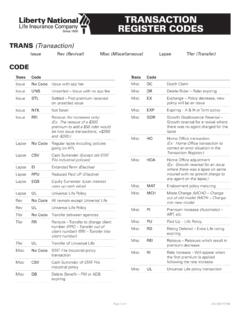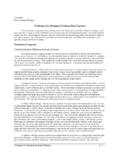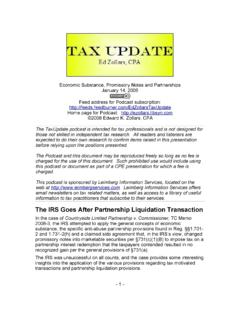Transcription of ETHEREUM: A SECURE DECENTRALISED …
1 ethereum : A SECURE DECENTRALISED GENERALISED TRANSACTION LEDGEREIP-150 REVISIONDR. GAVIN WOODFOUNDER, ethereum & blockchain paradigm when coupled with cryptographically-secured transactions has demonstrated itsutility through a number of projects, not least Bitcoin. Each such project can be seen as a simple application ona DECENTRALISED , but singleton, compute resource. We can call this paradigm a transactional singleton machine implements this paradigm in a generalised manner. Furthermore it provides a plurality of such resources,each with a distinct state and operating code but able to interact through a message-passing framework with discuss its design, implementation issues, the opportunities it provides and the future hurdles we ubiquitous internet connections in most placesof the world, global information transmission has becomeincredibly cheap.
2 Technology-rooted movements like Bit-coin have demonstrated, through the power of the default,consensus mechanisms and voluntary respect of the socialcontract that it is possible to use the internet to makea DECENTRALISED value-transfer system, shared across theworld and virtually free to use. This system can be saidto be a very specialised version of a cryptographically se-cure, transaction-based state machine. Follow-up systemssuch as Namecoin adapted this original currency appli-cation of the technology into other applications albeitrather simplistic is a project which attempts to build the gen-eralised technology; technology on which all transaction-based state machine concepts may be built.
3 Moreover itaims to provide to the end-developer a tightly integratedend-to-end system for building software on a hitherto un-explored compute paradigm in the mainstream: a trustfulobject messaging compute are many goals of thisproject; one key goal is to facilitate transactions be-tween consenting individuals who would otherwise haveno means to trust one another. This may be due togeographical separation, interfacing difficulty, or perhapsthe incompatibility, incompetence, unwillingness, expense,uncertainty, inconvenience or corruption of existing legalsystems. By specifying a state-change system through arich and unambiguous language, and furthermore archi-tecting a system such that we can reasonably expect thatan agreement will be thus enforced autonomously, we canprovide a means to this in this proposed system would have severalattributes not often found in the real world.
4 The incor-ruptibility of judgement, often difficult to find, comes nat-urally from a disinterested algorithmic interpreter. Trans-parency, or being able to see exactly how a state or judge-ment came about through the transaction log and rulesor instructional codes, never happens perfectly in human-based systems since natural language is necessarily vague,information is often lacking, and plain old prejudices aredifficult to , I wish to provide a system such that users canbe guaranteed that no matter with which other individ-uals, systems or organisations they interact, they can doso with absolute confidence in the possible outcomes andhow those outcomes might come [2013a] first proposed thekernel of this work in late November, 2013.
5 Though nowevolved in many ways, the key functionality of a block-chain with a Turing-complete language and an effectivelyunlimited inter-transaction storage capability remains and Naor [1992] provided the first work into theusage of a cryptographic proof of computational expendi-ture ( proof-of-work ) as a means of transmitting a valuesignal over the Internet. The value-signal was utilised hereas a spam deterrence mechanism rather than any kindof currency, but critically demonstrated the potential fora basic data channel to carry astrong economic signal,allowing a receiver to make a physical assertion withouthaving to rely upontrust. Back [2002] later produced asystem in a similar first example of utilising the proof-of-work as astrong economic signal to SECURE a currency was by Vish-numurthy et al.
6 [2003]. In this instance, the token wasused to keep peer-to-peer file trading in check, ensuring consumers be able to make micro-payments to suppli-ers for their services. The security model afforded bythe proof-of-work was augmented with digital signaturesand a ledger in order to ensure that the historical recordcouldn t be corrupted and that malicious actors could notspoof payment or unjustly complain about service deliv-ery. Five years later, Nakamoto [2008] introduced an-other such proof-of-work-secured value token, somewhatwider in scope. The fruits of this project, Bitcoin, becamethe first widely adopted global DECENTRALISED projects built on Bitcoin s success; the alt-coinsintroduced numerous other currencies through alterationto the protocol.
7 Some of the best known are Litecoin andPrimecoin, discussed by Sprankel [2013]. Other projectssought to take the core value content mechanism of the1 ethereum : A SECURE DECENTRALISED GENERALISED TRANSACTION LEDGEREIP-150 REVISION2protocol and repurpose it; Aron [2012] discusses, for ex-ample, the Namecoin project which aims to provide a de-centralised name-resolution projects still aim to build upon the Bitcoin net-work itself, leveraging the large amount of value placed inthe system and the vast amount of computation that goesinto the consensus mechanism. The Mastercoin project,first proposed by Willett [2013], aims to build a richerprotocol involving many additional high-level features ontop of the Bitcoin protocol through utilisation of a num-ber of auxiliary parts to the core protocol.
8 The ColouredCoins project, proposed by Rosenfeld [2012], takes a sim-ilar but more simplified strategy, embellishing the rulesof a transaction in order to break the fungibility of Bit-coin s base currency and allow the creation and tracking oftokens through a special chroma-wallet -protocol-awarepiece of work has been done in the area with discard-ing the decentralisation foundation; Ripple, discussed byBoutellier and Heinzen [2014], has sought to create a fed-erated system for currency exchange, effectively creatinga new financial clearing system. It has demonstrated thathigh efficiency gains can be made if the decentralisationpremise is work on smart contracts has been done by Szabo[1997] and Miller [1997].
9 Around the 1990s it became clearthat algorithmic enforcement of agreements could becomea significant force in human cooperation. Though no spe-cific system was proposed to implement such a system,it was proposed that the future of law would be heavilyaffected by such systems. In this light, ethereum maybe seen as a general implementation of such Blockchain ParadigmEthereum, taken as a whole, can be viewed as atransaction-based state machine: we begin with a gene-sis state and incrementally execute transactions to morphit into some final state. It is this final state which we ac-cept as the canonical version of the world of state can include such information as account bal-ances, reputations, trust arrangements, data pertainingto information of the physical world; in short, anythingthat can currently be represented by a computer is admis-sible.
10 transactions thus represent a valid arc between twostates; the valid part is important there exist far moreinvalid state changes than valid state changes. Invalidstate changes might, be things such as reducing anaccount balance without an equal and opposite increaseelsewhere. A valid state transition is one which comesabout through a transaction. Formally:(1) t+1 ( t,T)where is the ethereum state transition function. InEthereum, , together with are considerably more pow-erful then any existing comparable system; allows com-ponents to carry out arbitrary computation, while al-lows components to store arbitrary state between are collated into blocks; blocks arechained together using a cryptographic hash as a means ofreference.





